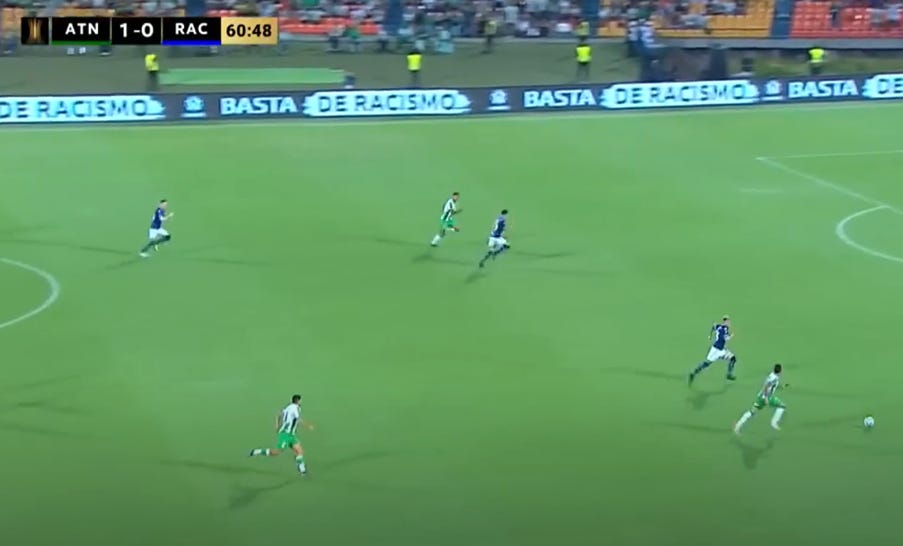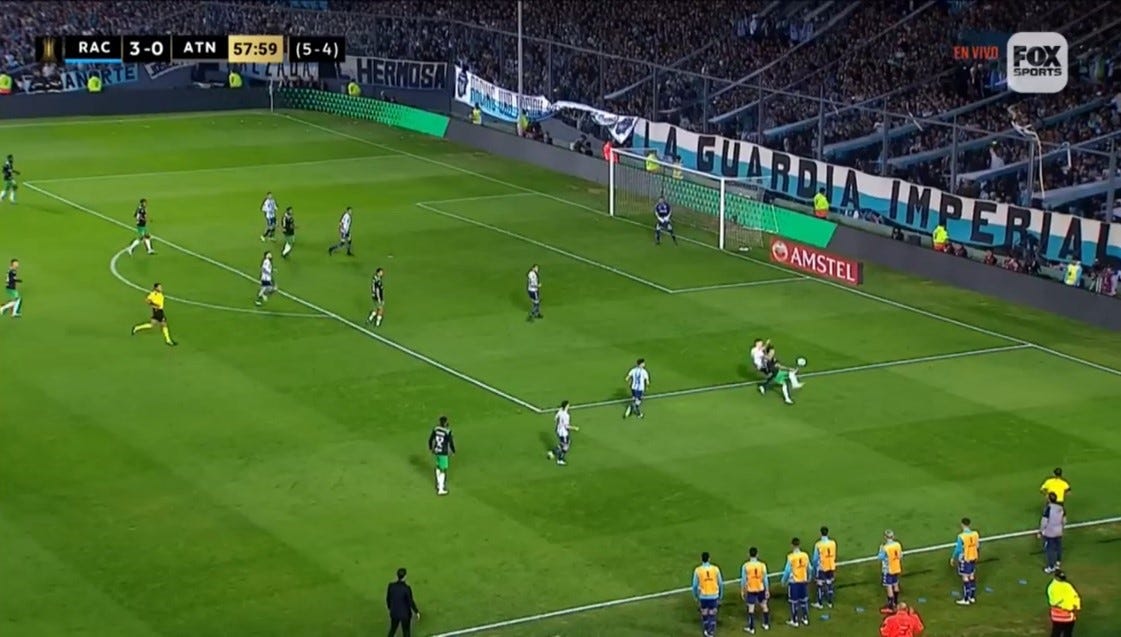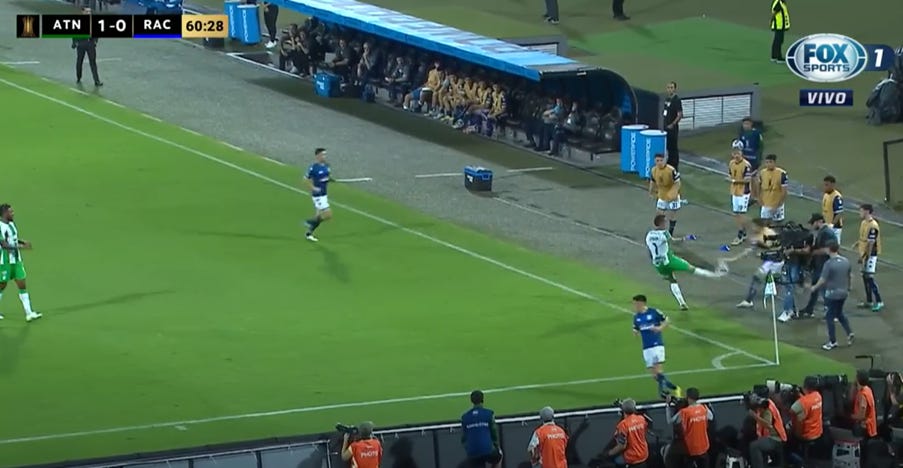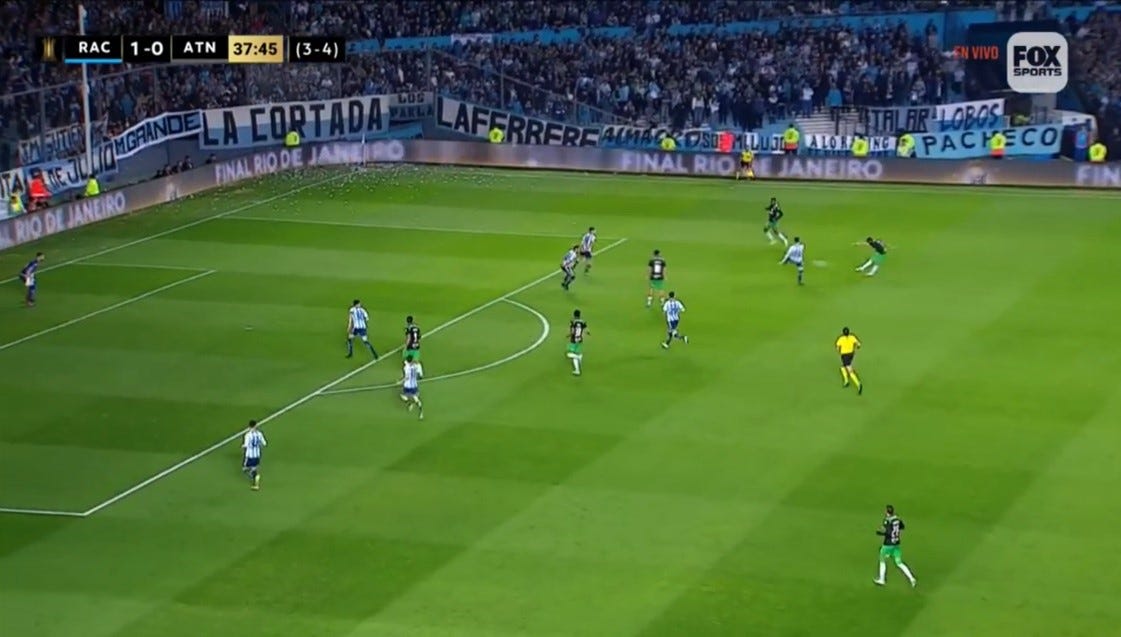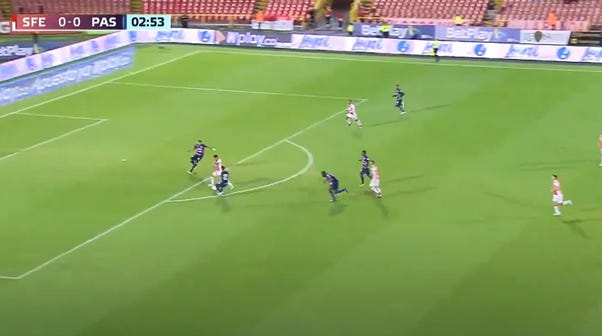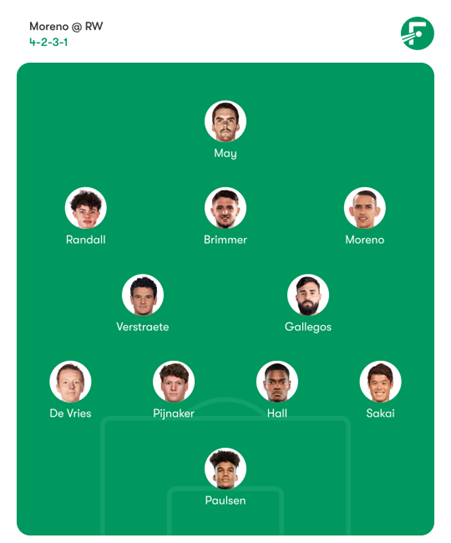Passion, range, and… long throws? What to Expect from Auckland FC's 'Miraculous' New Signing Neyder Moreno
Could the Colombian be the missing piece in Auckland FC’s jigsaw puzzle?
By Neyder Moreno’s own account, Auckland FC’s newest signing’s very life is a testament to divine intervention. At just seven months old, he tumbled down the staircase connecting the second and third floors of his family home in the aptly named Colombian town of Socorro. The staircase was lined with old nails, and one embedded itself in Moreno’s scalp.
Fortunately, local doctors successfully removed the nail during surgery. Had it been just a centimetre off in either direction, young Moreno would not have been so lucky. Hence, ‘miracle’ Moreno, the man Steve Corica hopes is the final jigsaw piece as he pursues A-League glory in Auckland FC’s inaugural season.
The Journey here
Auckland FC has not even kicked a ball in a competitive fixture yet, but in bringing Moreno to the club it feels like the A-League’s newest club has already been embroiled in somewhat of a transfer saga.
There have been all the hallmarks. Cryptic Instagram posts. Eternal speculation that the deal is all but done. Forays into the intricacies of immigration law.
But on Monday, the club finally confirmed New Zealand football’s worst-kept secret—if you could even call it that—when they announced the signing of Neyder Moreno.
Moreno, 27, has signed from Atlético Nacional, the most successful team in the history of the Categoría Primera A (Colombia’s first division). Since joining the Colombian giants, Moreno has been out on loan a handful of times, including to fellow Primera A mainstays Independiente Santa Fe and a return to his first professional club, Envigado F.C.
Moreno hails from the Envigado Academy, known as the ‘Cantera de Heroes’ (Quarry of Heroes), which has produced some of the biggest names in Colombian football, including James Rodríguez, Fredy Guarín, and Aston Villa star Jhon Duran.
Auckland FC marks Moreno’s first experience playing outside of Colombia. You would hope having a couple of fellow South Americans in Chilean Luis Felipe Gallegos and Uruguayan Guillermo May already signed to the club, should make the settling in process for Moreno as painless as possible.
Moreno’s stats: an inconsistent record
Over his career, Moreno’s numbers have been inconsistent. In all competitions, he has recorded 29 goals and 16 assists across 181 career games, with 110 of those as a starter. His standout season came in 2022 when he notched six goals and six assists while playing for Santa Fe. However, his time at Atlético Nacional has yielded only a handful of goals and assists each season. It’s fair to say that Moreno has never been an output machine.
As he joins Auckland FC, Moreno will likely be a bit rusty. He has played just four matches for Nacional in the first half of the year, all off the bench, totalling only 97 minutes—barely the equivalent of a full game. Given this lack of recent playtime, it seems unlikely that Moreno will take the field as a starter on Saturday, although stranger things have happened.
Checking the tape: What attributes does Neyder Moreno bring to the table
“Lies, damned lies, and statistics”
You can learn only so much about a player from the data. To truly evaluate a player, we must also consider the available footage.
The usual disclaimers apply here. Grainy YouTube compilations from the Primera A can only provide so much. In many cases, these videos are put out by agents or the players themselves to drum up some interest. This is not to say this is necessarily the case for Moreno, but rather that by the very nature of these videos, they are designed to make the subject look like they are Diego Maradona—or perhaps, in this case, Carlos Valderrama—in their prime.
Fortunately, I was able to track down on YouTube recordings of Moreno’s two outings for Nacional in last year’s Copa Libertadores round of 16 against Argentine side Racing club—managed by former Real Madrid and Argentina star Fernando Gago, who is now in charge at Boca Juniors. Moreno started both games on the right wing. If you’re interested in taking a look yourself, links to both games and highlights below (Moreno is #7):
Nacional were victorious in the first leg at home 4-2, but Racing turned it around in the second leg with three unanswered goals. I’ve now watched both games in full, and a few key aspects of Moreno’s play stood out to me.
First is his confidence—almost bordering on overconfidence—when striking the ball from distance. You can glimpse some of these spectacular shots in Auckland’s welcome video for their newest signing. Moreno is clearly an impressive ball striker off both feet, often beating goalkeepers with sheer velocity.
He’s also quite technically proficient. He can cross well off his right foot, though he has a tendency to arrow rather than whip his crosses in. His passing range is also impressive, and in both legs against Racing, Moreno took all the set pieces for Nacional—including long throw situations (more on that later).
However, against the Argentinians, Moreno’s delivery from freekicks was a mixed bag. At times, his teammates seemed uncertain about where he would send the ball, allowing Racing to clear it away. But it was Moreno’s freekick from this position that led to the opening goal of the first leg:
Moreno floats one towards the back post. A Racing player inadvertently deflects it off his shoulder, allowing Nacional captain Zapata to bundle it into the net. It doesn’t count as an assist for Moreno, but it was his delivery that caused Racing the problems that led to the goal. Zapata, for his troubles, collided with a teammate, and both went down injured whilst the other Nacional players celebrated. VAR checked the goal for offside, but it stood. It’s glorious Copa Libertadores melodrama at its very best.
Moreno does end up picking up his assist later on. Two-thirds of the way into the game, Nacional win the ball in the middle of the park and find Moreno on the Wing, who takes a nice touch:
Moreno is able to get his head up and spot Nacional striker Duque making a run towards the back post:
He delivers an inch-perfect cross into Duque, who slots it home. Moreno celebrates before the goal has even been scored.
Crafting chances is a strength of Moreno’s. Take this instance where he, playing for Santa Fe, picks the ball up in his own half and threads through a pass to his teammate, who fires his shot straight at the goalkeeper:
Or this delicate chip through to an open teammate:
That time it doesn’t come off, but it highlights that Moreno isn’t afraid to think outside the box.
This willingness to take risks was evident again in the second leg against Racing, when Moreno attempted something I had never seen before: an overhead kick cross. While it didn’t succeed, you can’t help but appreciate a player with a flair for the dramatic.
Another aspect that stood out to me was Moreno’s movement. He’s a powerful runner and a tenacious presser. Though he isn’t the tallest, he covers the ground with long strides. In the second leg against Racing, as Nacional worked to protect their first-leg lead, Moreno could often be spotted diligently tracked back to support his fullback.
Regarding his dribbling, which Steve Corica noted as one of Moreno’s strengths, I would characterise Morena as more of a ball carrier than dribbler. Moreno doesn’t try to commit a fullback on the wing and beat them with guile or feints. Instead, he prefers to drive through the half spaces, pushing the ball past incoming challenges.
As alluded to earlier, Moreno appears to possess a long throw. While Moreno is no Rory Delap, he can deliver the ball quite a distance into the box. Check out this example from the match against Racing:
But what impressed me most about Moreno was his passion. He’s the type of player who wears his heart on his sleeve, and I think Auckland FC fans are going to love this.
Take this moment from the First Leg against Racing, where Moreno wins a challenge and kicks the ball away before a quick throw-in can be taken. Inevitably, a scuffle breaks out between the teams, but Moreno doesn’t shy away. Should it have resulted in a yellow card? Probably, but Moreno manages to avoid one, and, in fact, the opponent who squares up to him is the only player whose name sees the book.
Room for growth
When it comes to areas for improvement, the most significant aspect for me is his decision-making. He tends to make rash choices at times. Consider some of the positions from which he’s scored those spectacular goals:
There’s no denying the quality of his strikes, but it raises the question of why he’s attempting shots from those positions in the first place. If Moreno had consistently scored from such ranges, he likely wouldn’t have been released from Nacional and found himself in the A-League.
If we’re being honest, Moreno will not score from that range more often than not. The numbers seem to bear that out. Over his career, Moreno has averaged a healthy number of shots per 90. But his career shots-on-target percentage of 36.1% leaves much to be desired. Equally, in Moreno’s handful of Copa Libertadores games, his average shot distance is 23.7 yards—i.e. outside the box.
Take this example from Nacional’s second leg against Racing, with the Colombians starting to wilt under Racing’s intimidating home crowd and intense press. This was Moreno’s only shot of the game:
Unsurprisingly, the shot sails over the bar. The xG on that shot? Less than 0.01. One would have to think there were better options than attempting a shot from that position.
I’ve also noticed Moreno sometimes makes questionable choices with his passing. Consider this example where he receives the ball in a central area with two players ahead of him:
In the next screenshot, the optimal option appears to be sliding the ball into the winger to go through into the box. Instead, Moreno puts the ball through into the striker, who immediately has two players on him when he receives it.
The opposition is able quite easily to recover the ball, and the attack fizzles out. This is just one example, but there were several other instances in the footage I reviewed that reflected a similar pattern.
Profile and Playing Style
Profile is an increasingly important consideration in football. A stiff target man might dominate the air, but in a team that wants to zip the ball around and get in behind, said target may resemble the Ents from the Lord of the Rings—slow and cumbersome.
Burnley FC set pieces c. 2017. Treebeard as Chris Wood
When it comes to Moreno’s profile, who better to consult than the man who brought him to New Zealand? As Steve Corica puts it, “Neyder is a very fast, technical player that loves to dribble one-v-one against defenders.”
Corica clearly views Moreno as his one-on-one specialist—a highly sought-after profile in football. Take Spanish star Nico Williams from Athletic Bilbao, for example. Pep Guardiola has two such talents at Manchester City: Jérémy Doku and Sávio.
Closer to home, Ben Old stands out as New Zealand’s premier one-on-one specialist with his exceptional dribbling skills. It’s this ability that likely facilitated his move to Saint-Étienne in Ligue 1. Meanwhile, Finn Surman, who is equally gifted in his own position, also made an overseas move, albeit to a less prestigious league in the MLS, where he has yet to debut. In contrast, by all accounts, Old has made a strong start to his new life in France.
This highlights my point: increasingly, teams are prioritising player profiles over raw talent when making their selections.
But I digress. Enough about their former players.
I don’t quite see Moreno as this type of player. As I mentioned earlier, he tends to beat defenders more directly or uses his passing to navigate the opposition press. Still, it seems likely that Auckland FC, at least in the short term, views Moreno primarily as a right winger and direct competition for Logan Rogerson. As I write this, Rogerson has just struck a beautiful goal against Malaysia for the All Whites, stepping up to his newfound competition.
As I discussed in my last post, Moreno can also play behind the striker, where he’d be competing with freshly appointed vice-captain Jake Brimmer. From the clips I’ve seen, he can operate effectively on the left as well, and given his comfort with his left foot, I don’t see any reason why this option couldn’t work in a pinch.
In the long term, I’d like to see Corica experiment with deploying Moreno at the No. 10 position. His willingness to dribble in central areas, combined with his good range of passing and pressing ability, suggests he could excel there. Corica has expressed a desire to build a possession-based, high-pressing team, and I can envision Moreno working well in tandem press with a striker like Guillermo May in the 4-4-2 out-of-possession shape most top teams employ these days in their press.
To finish this post on a bombshell, and this is certainly not to say Moreno is the same calibre of player, but I do see some parallels to a player like Ángel Di Maria. Other than their slight resemblance, there are similarities in their ability to operate effectively at No. 10 and on both wings, and both have a strong technical arsenal—though it’s fair to note that Di María is a far superior dribbler. Ideally, we’ll see the Moreno who resembled Di María’s standout performance in the 2022 FIFA World Cup final, rather than the less effective version we witnessed during his time at Manchester United about a decade ago.
Of course, this is just one unqualified opinion. But in Moreno, I think Auckland has picked up a very good player who genuinely elevates the level of the team. Supporters should look forward to seeing him take to the pitch—hopefully, if only briefly, this Saturday. See you all there!







